– a three day art course at Newlyn School of Art
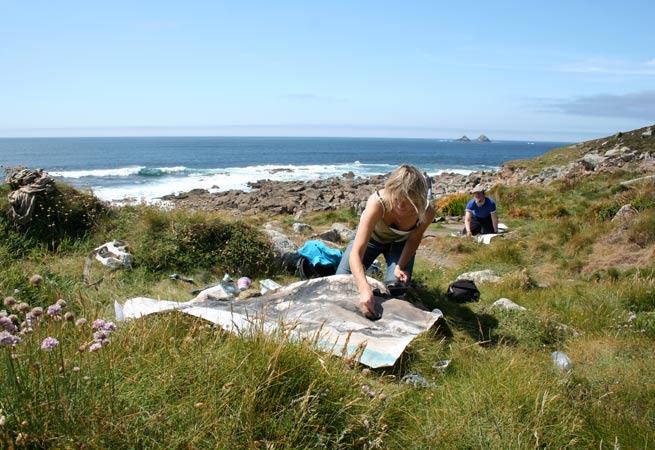
There’s a particular kind of peninsula light that has attracted artists to this furthermost tip of Cornwall since the 1880s. A colony of artists, lapping up the light and the stunning scenery in and around Newlyn back then, became known as ‘the Newlyn School of Painters’, with Stanhope Forbes setting up his celebrated Forbes School of Painting in 1899. Fast forward a century or so, and it’s the Newlyn School of Art run by Henry Garfit, which offers exciting and inspiring courses in painting, drawing, printmaking, pottery, stone carving and mentoring for aspiring artists.

Taught by established artists rather than art teachers, who are willing to share their own approaches, ways of working and top tips, the beauty of it is that you don’t have to be an artist to have a go. Anyone can enrol. As someone who can’t paint for toffee, it’s encouraging to think that it’s never too late to learn. And with that in mind I took the plunge and signed on the dotted line.
Being a writer, I thought I’d try the three day course with Mousehole-based artist Tom Rickman, called Paint, Landscape and Light, as it involved making a handmade sketchbook to record our experiences. According to the blurb, through observation and notation, we’d be ‘exploring light and colour, and discovering how to transfer this into our practice in a poetic, conceptual and metaphorical sense.’
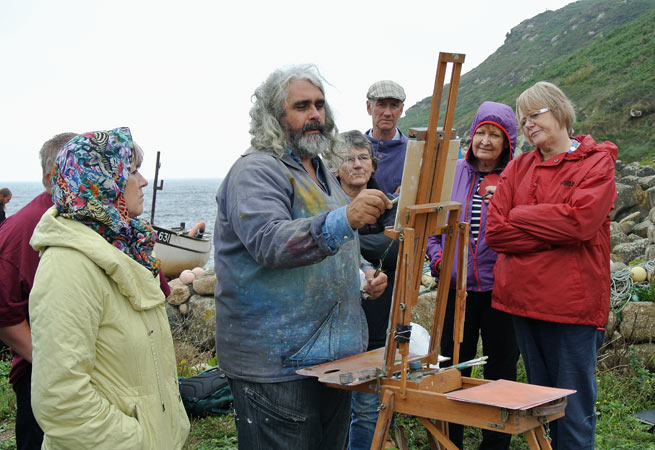
Day 1
It’s a killer cycle up Chywoone Hill to get to the school, but the sublime views over Mount’s Bay freewheeling back down again are worth it. Don’t worry there’s free onsite parking if you’re driving. There are ten of us students, from as far afield as Norway and New Zealand, and after intros over coffee it’s time to get stuck in. We start by creating a colour wheel in the studio using the three primaries plus white. It requires a lot of concentration, the art of blending shades of grey proving more difficult than you’d think (handy though for painting skies like today’s).
As well as colour we’ll be observing light, so it’s less about the form and more abstract. Rather than teaching techniques, Tom’s approach focuses on looking and discovering. As a tutor he wants people to take new freedoms away with them. He explains: “The aim is to concentrate on the process rather than the end product. Keep things simple. It’s a sensory experience as colours are a very emotive thing.”
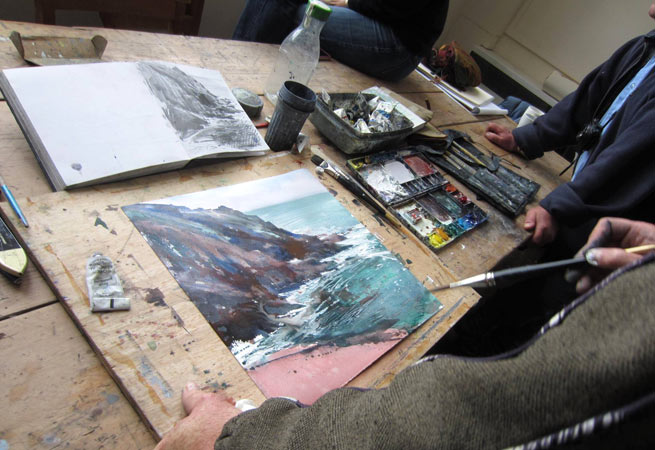
Taking paints, palettes, brushes and boards provided by the school with us, after lunch we drive out to Drift Reservoir to paint en plein air. Tom suggests we try and relate the body of water with the expanse of sky, and the strip of land sandwiched in between. Working out what to frame in terms of composition and which colours to use proves to be a quite a learning curve for me, but with Tom’s generous help we all start to get the hang of it. Back to Newlyn for a show-and-tell briefing, it’s great to see what the more experienced artists have produced in terms of style and application, giving me some ideas of how to tackle tomorrow’s task(s).
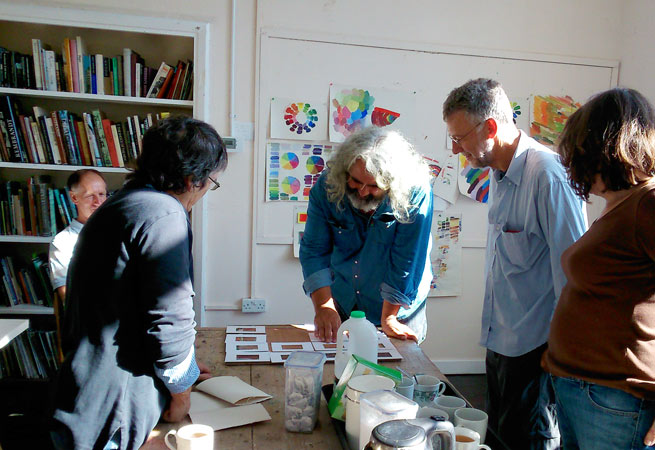
Day 2
Loading up the cars with all our art clobber, we head out to Carn Gloose on the rugged north coast, for a longer day of painting in the landscape. There’s a variety of views and subjects to choose from: cliffs, rocks, sea, fields, moorland, flora, mine engine houses. Sat roadside to paint the vibrant purple heather, I end up staying in the same spot for the duration, just swivelling around 360 degrees to take in a new subject/muse: blackberries, cow parsley stalks, fields of gold and a radio mast, a Van Gogh-like impressionistic daisy, Longships lighthouse on the horizon. It’s exhausting work, fuelled by a lunchtime pasty courtesy of Tom’s St Just run, but I’m genuinely pleased with my efforts.
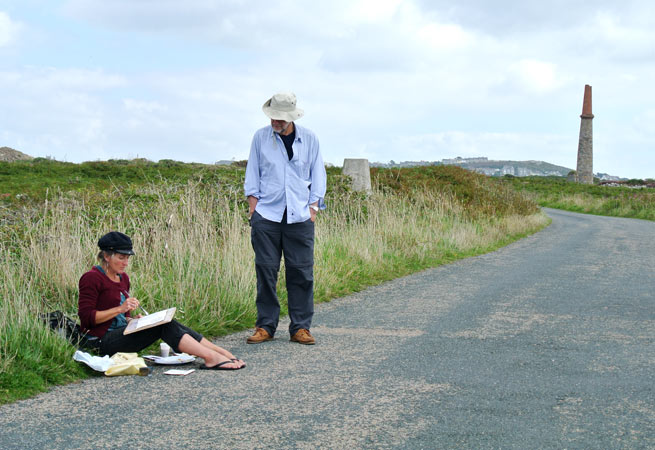
In the evening, there was a sunset excursion to the same location to make quick schematic diagrams of the changing light. Writing down what the colours were, where they were and in what proportion, meant this information could be used later.
“I don’t paint sunsets in situ as the light’s changing so fast,” shares Tom. “I have a good colour memory so make notes instead. The more you do it, the more internal vocabulary you acquire. I’d much rather sit and absorb the experience. Take it all in.”
Me too, because as sunsets go Cornish ones are pretty spectacular.
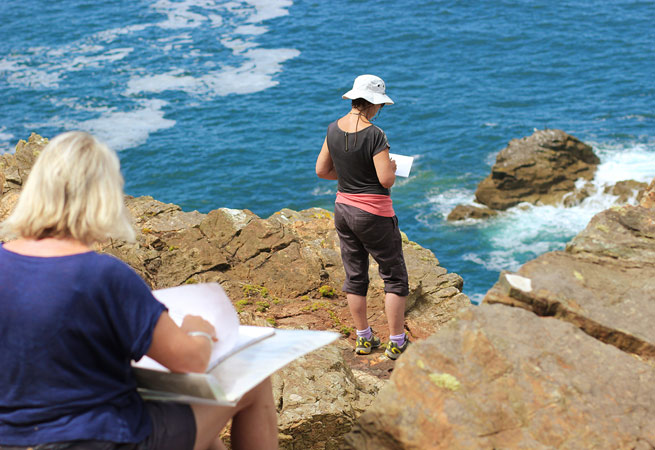
Day 3
We’re off to Penberth Cove, with its peaceful wooded valley, quaint fishermen’s cove, wild seas and granite outcrops. It’s a humbling feeling to think that artists like Stanhope Forbes, Henry Scott Tuke, Harold and Laura Knight, ‘Lamorna’ Birch and Alfred Munnings once painted here too. Gives a real sense of history and continuity. According to Tom, those feelings and moods, our inner dialogue, feed into our work. He uses several notebooks (one for diary entries, one for words, fragments of lines and poems, and a little book for pencil sketches) as ways of capturing some of that dialogue, which then goes on to inform his painting.
I’m not sure what I’ve managed to capture, but the course has been an enlightening introduction to the (for me) mysterious world of landscape painting. It’s been great to share that experience with the group, a friendly bunch who all had something to contribute, and I’ve come away with drawings, paintings and snatched lines of poetry that I’m collating into a booklet. As a total novice I’m happy with that.
Newlyn School of Art have more short outdoor painting courses than any other provider in the country, and some of the most established artists offering to share their experience and knowledge with students throughout the year.
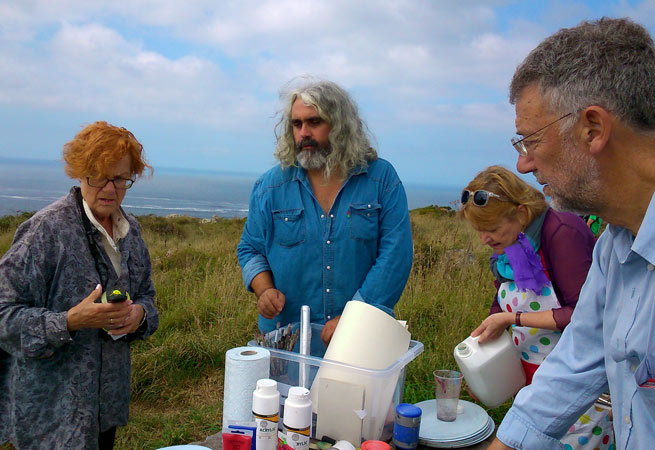
To find out more about the School and the courses they run visit: www.newlynartschool.co.uk
Stay nearby at one of our Newlyn Cottages >